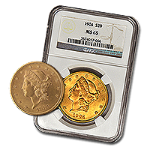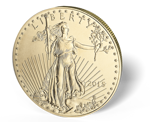The South African Krugerrand
The Krugerrand was first produced by the South African Mint in 1967, when South Africa was still part of the British empire, and the coin was the first governmental gold bullion coin to be priced on its gold content (one troy ounce of gold) rather than its face value. This was done as a means of making South African gold available to the world market in general and private investors in particular.
The success of the Krugerrand was so universal that in the early 1980’s they enjoyed a near 90% market share of the gold bullion coin industry. While the United States banned the private ownership of gold bullion with Franklin D. Roosevelt’s 1933 Executive order, the order did allow for everyday citizens of the United States to own foreign coins. The Krugerrand fell into this “foreign coin “category because it was issued as legal tender.
The Stumbling Block of Apartheid
Importation of the Krugerrand was unlawful in many nations in the west owing to South Africa’s apartheid policies. A ban on importing of South African goods and other sanctions resulted in isolating the country for more than ten years until the 1990s when political reforms ended apartheid.
Gold Mines in an Ancient Sea
The Krugerrand’s history is shrouded in politics, war and human greed and has it’s origin a 60-mile stretch range of hills known as Afrikaans Witwatersrand (translated “White Water Ridge”) where gold was discovered in 1884. The name was taken from the white quartzite ridge, where the sediment was located. The gold mines in this area are situated around an ancient sea (some estimate at over 2700 million years old) where rivers left their sediments mixed with sand and gravel, which became a rich mixture containing the gold. Tens of thousands of gold miners from around the world assaulted the area. In 1899, the British government sought equal rights between the miners and Boers, leading to the Boer War. Compromises were arrived at by 1920 the Rand Refinery was officially set as the refinery for all South African gold.
The First of it’s Kind and an Inspiration for Others
The gold Krugerrand’s popularity inevitably motivated other countries to mint their own gold bullion coins such as the Canadian Maple Leaf in 1979, the United States Golden Eagle in 1986, and the Austrian Philharmonic in 1989.
Why do Krugerrands Look so Unique?
Because Krugerrand gold coins were issued as legal tender its composition was designed for more durability. Since copper alloy gold coins are more resistant to wear than 24 karat gold coins, the Krugerrand is .9170 pure, or 91.7% gold, with the remaining 8.3% being copper. The color of the coin is closer to a subtle orange hue than gold coins combined with silver. Each 1 oz coin weighs 33.93 grams (31.1 grams pure gold and 2.83 grams copper).
A Unique Name for a Unique Coin
The name of this South African coin is a blend of the last name of the prominent Boer opposition fighter and first president of the South African Republic, Paul Kruger, and the name of the South African currency, the rand. The coin displays the image of Paul Kruger, designed by artist Otto Schultz, on the obverse (front) of the coin and a springbok, a prominent national symbol of the South African Republic, designed by Coert Steynberg, on the reverse (back). On the reverse side are the words “South Africa” and “fine gold” presented in both English and Afrikaans.
Available in a Variety of Sizes
Today Krugerrands are not only sold in 1 ounce units but are sold in fractional units as well. Since 1980 Krugerrands have been issued in ½ ounce, ¼ ounce and 1/10 ounce increments.
The South African Mint Company issues limited edition proof Krugerrands designed for collectors. These coins carry a premium over bullion price, as well as non-proof Krugerrands which also have an additional cost above gold bullion value. They can be differentiated from the bullion Krugerrands by the serration count on the edge of the coin. Proof coins have 220 while bullion coins have 160.














